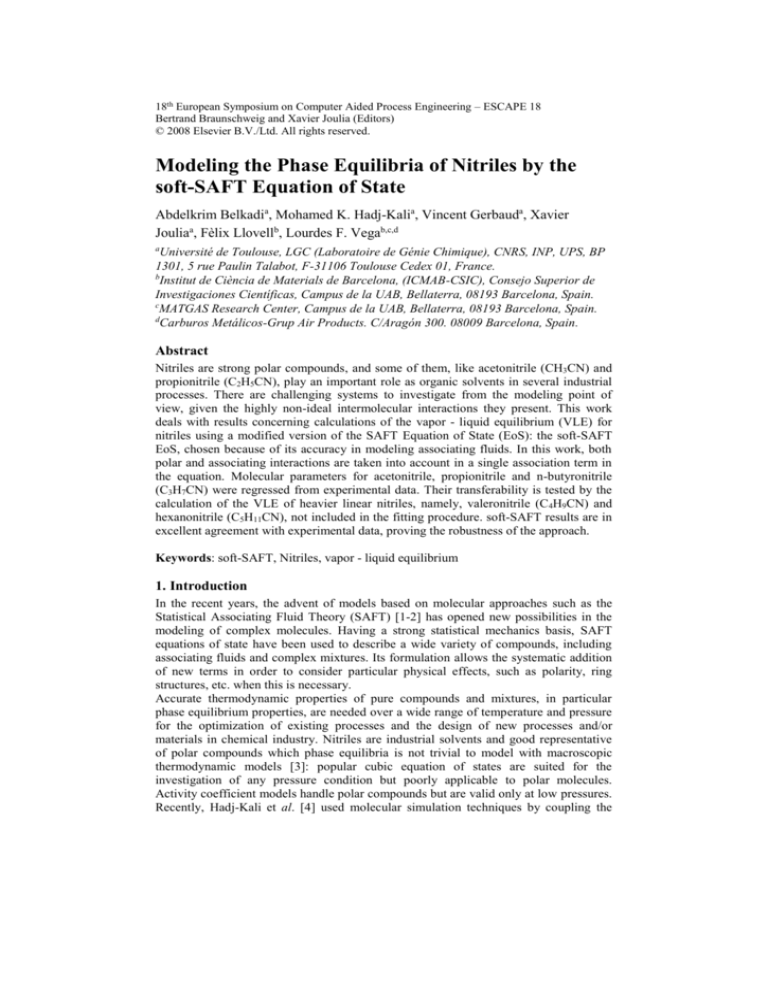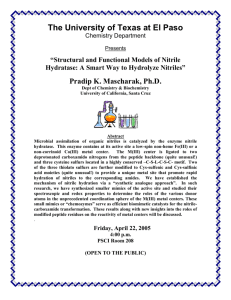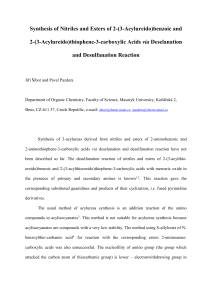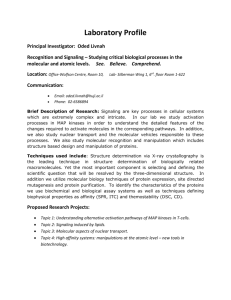
18th European Symposium on Computer Aided Process Engineering – ESCAPE 18
Bertrand Braunschweig and Xavier Joulia (Editors)
© 2008 Elsevier B.V./Ltd. All rights reserved.
Modeling the Phase Equilibria of Nitriles by the
soft-SAFT Equation of State
Abdelkrim Belkadia, Mohamed K. Hadj-Kalia, Vincent Gerbauda, Xavier
Jouliaa, Fèlix Llovellb, Lourdes F. Vegab,c,d
a
Université de Toulouse, LGC (Laboratoire de Génie Chimique), CNRS, INP, UPS, BP
1301, 5 rue Paulin Talabot, F-31106 Toulouse Cedex 01, France.
b
Institut de Ciència de Materials de Barcelona, (ICMAB-CSIC), Consejo Superior de
Investigaciones Científicas, Campus de la UAB, Bellaterra, 08193 Barcelona, Spain.
c
MATGAS Research Center, Campus de la UAB, Bellaterra, 08193 Barcelona, Spain.
d
Carburos Metálicos-Grup Air Products. C/Aragón 300. 08009 Barcelona, Spain.
Abstract
Nitriles are strong polar compounds, and some of them, like acetonitrile (CH3CN) and
propionitrile (C2H5CN), play an important role as organic solvents in several industrial
processes. There are challenging systems to investigate from the modeling point of
view, given the highly non-ideal intermolecular interactions they present. This work
deals with results concerning calculations of the vapor - liquid equilibrium (VLE) for
nitriles using a modified version of the SAFT Equation of State (EoS): the soft-SAFT
EoS, chosen because of its accuracy in modeling associating fluids. In this work, both
polar and associating interactions are taken into account in a single association term in
the equation. Molecular parameters for acetonitrile, propionitrile and n-butyronitrile
(C3H7CN) were regressed from experimental data. Their transferability is tested by the
calculation of the VLE of heavier linear nitriles, namely, valeronitrile (C4H9CN) and
hexanonitrile (C5H11CN), not included in the fitting procedure. soft-SAFT results are in
excellent agreement with experimental data, proving the robustness of the approach.
Keywords: soft-SAFT, Nitriles, vapor - liquid equilibrium
1. Introduction
In the recent years, the advent of models based on molecular approaches such as the
Statistical Associating Fluid Theory (SAFT) [1-2] has opened new possibilities in the
modeling of complex molecules. Having a strong statistical mechanics basis, SAFT
equations of state have been used to describe a wide variety of compounds, including
associating fluids and complex mixtures. Its formulation allows the systematic addition
of new terms in order to consider particular physical effects, such as polarity, ring
structures, etc. when this is necessary.
Accurate thermodynamic properties of pure compounds and mixtures, in particular
phase equilibrium properties, are needed over a wide range of temperature and pressure
for the optimization of existing processes and the design of new processes and/or
materials in chemical industry. Nitriles are industrial solvents and good representative
of polar compounds which phase equilibria is not trivial to model with macroscopic
thermodynamic models [3]: popular cubic equation of states are suited for the
investigation of any pressure condition but poorly applicable to polar molecules.
Activity coefficient models handle polar compounds but are valid only at low pressures.
Recently, Hadj-Kali et al. [4] used molecular simulation techniques by coupling the
2
A. Belkadi et al.
Gibbs Ensemble Monte Carlo method with a suitable interaction force field to model
vapor - liquid equilibrium of such molecules; although this approach is accurate, it
requires intensive computational efforts as compared to equation of state models.
The approach used in this work concerns the use a molecular based equation of state,
namely the soft-SAFT EoS, developed by Blas and Vega [5-6] to investigate the phase
behavior of nitriles. Unlike classical PR or SRK equations of state that require molecule
properties (critical temperature, critical pressure and acentric factor) to model the PVT
properties on compounds, molecular based EoS require to describe the gross chemical
structure of molecules in terms of molecular parameters, enabling to find suitable
correlations between compounds from the same homologous serie.
The present paper is organized as follows: a brief background of the soft-SAFT EoS is
exposed. Then, details on former published models and the proposed model are
provided. Finally, molecular parameters are regressed for the three lightest nitriles of
the linear nitrile family and their transferability is validated for heavier compounds of
the same family, in a pure predictive manner.
2. The soft-SAFT approach
The soft-SAFT EoS is a variant of the original SAFT equation proposed by Chapman
and co-workers [1] and Huang and Radosz [7-8] based on Wertheim’s first order
Thermodynamics Perturbation Theory (TPT) [9-10]. Since the SAFT equation and its
modifications have been extensively revised elsewhere [11], only the main features of
the equation are retained here.
SAFT-type equations of state are written in terms of the residual Helmholtz energy:
a res T , P, N aT , P, N aid T , P, N
(1)
Where a(T,V,N) and aideal(T,V,N) are the total Helmholtz energy per mole and the ideal
gas Helmholtz energy per mole at the same temperature and density, respectively. The
residual Helmholtz energy is the sum of the microscopic contributions to the total free
energy of the fluid, where each term in the equation represents different microscopic
contributions to the total free energy of the fluid:
ares aLJ achain aassoc
(2)
The main difference between the soft-SAFT equation and the original equation [1] is the
use of the Lennard–Jones (LJ) intermolecular potential for the reference fluid (with
dispersive and repulsive forces into the same term), instead of the perturbation scheme
based on a hard-sphere reference fluid plus dispersive contributions to it. This
difference also appears in the chain and association term, since both terms use the radial
distribution function of the reference fluid. The LJ potential includes a dispersive term
in r-6 and a repulsive term in r-12. It exhibits an energy minimum versus the interaction
distance and is thus more realistic that the HS + dispersion potential.
The accurate LJ EoS of Johnson et al. [12] is used for the reference term. The chain
term in the equation comes from Wertheim’s theory, and it is formally identical in the
different versions of SAFT. In our case, it is expressed as:
a chain k BT xi 1 mi ln g LJ
(3)
i
Where ρ is the molecular density of the fluid, T is the temperature and kB is the
Boltzmann constant. In the soft-SAFT case, it is applied to tangent LJ spheres of chain
Modeling the Phase Equilibria of Nitriles by the soft-SAFT Equation of State
3
length m that are computed following the pair correlation function gLJ, evaluated at the
bond length σ.
The association term comes from the first-order Wertheim’s TPT for associating fluids.
The Helmholtz free energy change due to association is calculated from the equation
a assoc k BT
xi
i
ln X i X i M i
2 2
(4)
Where Mi is the number of associating sites of component i and X i the mole fraction of
component i not bonded at site α which accounts for the contributions of all associating
sites in each species:
X i
1
x X
1 N avog
j
j
i j
j
(5)
3. Results and discussion
3.1. Modeling nitriles
In the comprehensive work of Spuhl et al. [13], acetonitrile (ACN) was modeled by
three different schemes: the first considers ACN as a chain of hard spheres, the second
as an associative molecule with one associating site on the nitrile contribution CN, and
the third one takes into account the dipolar moment of the ACN. Results show that the
model which considers the dipolar moment is better than the two others although the
associative model also showed good results. Earlier, Jackowski’s experimental studies
of the propionitrile by NMR [14] lead to the presumption that self association
interactions must be considered in these systems.
The soft-SAFT formalism is built explicitly to take into account such self association,
being naturally suited, in principle, for the self-associating nitriles. The equation
requires at least three parameters for each compound, namely: m, the chain length, σ, the
diameter of the LJ sphere forming the chain, and ε, the interaction energy between the
spheres. For associative molecules, two additional parameters are needed per
association site, the association volume κHB and the association energy εHB.
The model proposed in this work describes all nitriles by a single association site
located on the CN group. The dipolar moment is not explicitly considered and their
effects are embedded into the other fitted molecular parameters [15].
All parameter values are obtained by fitting the saturated liquid densities (ρliq) and vapor
pressures (Psat) from the Design Institute for Physical Properties (DIPPR) available in
Simulis Thermodynamics component (http://www.prosim.net/) for each molecule by
minimization the following objective function called absolute average deviation:
1
AADY % P
N
Yi cal Yi exp
Yi exp
i 1
NP
2
Where Y represents the property data used for the regression, namely ρliq and Psat .
(6)
4
A. Belkadi et al.
3.2. Methodology
The first three linear nitriles (CH3CN, C2H5CN and C3H7CN) are used as reference for
the optimization of the soft-SAFT EoS molecular parameters (m, σ and ε) by fitting the
available VLE data summarized in table 1. The association parameters (εHB and κHB) are
fitted differently for acetonitrile and propionitrile. Light nitriles like acetonitrile and
acrylonitrile often display peculiar behavior because of the short radical bonded to the –
CN group, which dominates the interactions. As a matter of fact in UNIFAC group
contribution method, acetonitrile and acrylonitrile are considered as unique groups
while other nitriles can be constructed from -CHx and -CH2CN groups. Here we find
that acetonitrile requires a larger association volume than other nitriles, a fact also
observed for the alkanol family in previous studies [16]. Propionitrile association
parameters are then kept constant for the rest of the nitriles.
From the observations of Huang and Radosz [7] about the relation between the
association strength εHB and volume κHB value, we can classify nitriles as an associating
fluid stronger than alkanols but with a smaller association volume [16], hinting at the
fact that associated nitriles may interact at distances smaller than H-bonds (typically 2.8
Ǻ) found in alkanols.
Table1: Molecular Parameters for the n-nitriles family (C2-C4).
molecule
T range
(K)
m
σ (Ǻ)
ε/kB (K)
εHB/kB (K)
κHB(Å3)
AAD
ρliq(%)
AAD
Psat(%)
CH3CN
280-528
1.45
3.70
268.0
8425
69
0.70
2.03
C2H5CN
283-553
1.55
3.97
272.0
8425
49
0.92
2.10
C3H7CN
283-553
1.65
4.22
279.3
8425
49
0.80
3.50
Experimental vapour pressure and density-temperature data are plotted along with the
description of the soft-SAFT model in Figure 1. The absolute average deviation on
density and vapor pressure is below 1% and in the 2-4% range respectively. Figure 1
shows that the fitting is indeed excellent, except near the critical point. This was
expected, since we are using an analytical equation of state, in which the density
fluctuations occurring near the critical region are not explicitly expressed. Additional
mathematical treatments like renormalization group theory have been shown to correct
effectively the VLE near the critical point [16] but, since for the applications we are
interested in are far from the critical region and the calculations with crossover only
improve the region near the critical point, they are not considered here.
An advantage of having parameters with physical meaning is that their physical trend
can be investigated within the same family. Therefore, as in previous works, we have
linearly correlated the three molecular parameters m, mσ3 and mε with the molecular
weight of the compounds within the same chemical family [17-18]. This allows
obtaining a set of transferable parameters as a function of the molecular weight
(equations 7). These correlations are established from the optimized parameters given in
table 1 and are obtained with a correlation coefficient greater than 0.98.
Modeling the Phase Equilibria of Nitriles by the soft-SAFT Equation of State
a)
5
b)
Figure 1 n-nitriles (acetonitrile [circle], propiontitrile [square] and butyronitrile [cross]) phase
equilibria (a) temperature-density diagram, (b) Pressure-temperature diagram. Symbols are from
DIPPR data [19] while solid lines stand for soft-SAFT calculations.
m 0.0083 M W 1.1083
(7.a)
m 3 2.1143 M w 13 .878
(7.b)
m / k B 3.025 M W 263 .53
(7.c)
Units of σ and ε/kB are Å and K, respectively.
Using these correlations, VLE properties of heavier linear nitriles of the same family
(Valeronitrile (C4H9CN) and Hexanonitrile (C5H11CN)) are predicted, without any
further fitting on supplementary experimental data. The maximum absolute average
deviation to density is obtained for Hexanonitrile (0.88%) with an absolute average
deviation to the vapor pressure near 3% for both molecules leading to a very good
agreement comparing to the DIPPR data [19] as highlighted by figure 2.
a)
b)
Figure 2 Vapor-liquid equilibria of valeronitrile [triangle up] and hexanonitrile [triangle down].
(a) temperature-density diagram, (b) Pressure-temperature diagram. Symbols represent DIPPR
data [19], while solid lines are soft-SAFT predictions.
6
A. Belkadi et al.
Despite the discrepancy in the near critical region, the absolute average deviation on
vapor pressure is higher than 2% in both cases. The overall agreement with
experimental data is very good, proving the transferability of the parameters used for
these predictions.
4. Conclusion
A molecular model for the n-nitrile chemical family with the soft-SAFT approach was
developed. n-nitriles were modeled as LJ chains with one associating site mimicking the
strong interactions of the –CN group. Once molecular parameters for the first members
of the family were obtained by fitting to available VLE equilibrium data, a correlation
of these parameters with the molecular weight of the compounds was proposed, which
can be used in a predictive manner for heavier members of the family. A good
agreement was obtained comparing the DIPPR data with small discrepancies near the
critical region, as expected, since the classical version of the soft-SAFT equation was
used. The linear correlations were successfully used to predict the phase behavior of
heavier compounds, in excellent agreement with experimental data, highlighting the
reliability of the model.
The authors acknowledges the Ministère de l’Enseignement Supérieur et de la Recherche de
France (MESR) for its grants and the CTP 2005 project (Convention Région N° 05018784). This
work has been partially financed by the Spanish Government (project CTQ2005-00296/PPQ) and
the Catalan government (projects SGR2005-00288 and ITT2005-6/10.05)
References
[1]. W. G. Chapman, K. E. Gubbins, G. Jackson, and M. Radosz, Ind. Eng. Chem. Res., 29 (1990)
1709-1721.
[2]. W.G. Chapman, G. Jackson and K. E. Keith Gubbins, Mol. Phys., 65 (1988) 1057-1079.
[3]. J. Vidal, Thermodynamics: Applications in Chemical Engineering and the Petroleum
Industry, Editions Technip, 2003, ISBN2710808005.
[4]. M. K. Hadj-Kali, V. Gerbaud, X. Joulia, A. Boutin, P. Ungerer, C. Mijoule and J. Roques,
Computer Aided Chemical Engineering, 14 (2003) 653-658.
[5]. F.J. Blas and L.F. Vega, Ind. Eng. Chem. Res., 37 (1998) 660-674.
[6]. F.J. Blas and L.F. Vega, Molec. Phys., 92 (1997) 135.
[7]. S. H. Huang and M. Radosz, Ind. Eng. Chem. Res., 29 (1990) 2284-2294.
[8]. S. H. Huang and M. Radosz, Ind. Eng. Chem. Res., 30 (1991) 1994-2005.
[9]. M. S Wertheim. J. Stat. Phys., 35 (1-2) (1984) 19-34.
[10]. M. S.Wertheim, J. Stat. Phys., 35 (1-2) (1984) 35-47.
[11]. E. A. Müller and K.E. Gubbins, Ind. Eng. Chem. Res., 40 (2001) 2193-2211.
[12]. J. K. Johnson, J. A. Zollweg and K. E. Gubbins, Molec. Phys. 78 (1993), 591.
[13]. O. Spuhl, S. Herzog, J. Gross, I. Smirnova, and W. Arlt. Ind. Eng. Chem. Res., 43 (2004)
4457-4464
[14]. K. Jackowski and E. Wielogorska,. Journal of Molecular Structure., 355 (1995) 287-290.
[15]. J. P.Hansen, I. R. McDonald, Theory of Simple Liquids., London Academic Press: 1990.
[16]. F. Llovell and L.F. Vega, J. Phys. Chem. B., 121 (110) (2006) 1350.
[17]. N. Pedrosa, J. C. Pàmies, J. A. P. Coutinho, I. M. Marrucho, and L. F. Vega, Ind. Eng.
Chem. Res., (2005) 44 7027-7037.
[18]. J. C. Pàmies, L. F. Vega, Ind. Eng. Chem. Res., 40 (2001), 2532.
[19]. DIPPR (Design Institute for Physical Property Data) from Simulis Thermodynamics.









